1. Background
Bhutan is a small, landlocked country with a total area of 3,839,400 ha situated on the southern slope of the Eastern Himalayas. The country is almost entirely mountainous with altitudes ranging from about 100 meters in the foothills to over 7,500 meters in the north. About 71% of the total geographical area is under forest cover (2,730,889 ha) and the constitution of Bhutan mandates to maintain at least 60% of forest cover in perpetuity. Bhutan’s extensive forest cover and pristine environment, coupled with its strong conservation efforts, has allowed the country to have exceptionally rich biodiversity with flourishing populations of some of the rarest flora and fauna on earth.
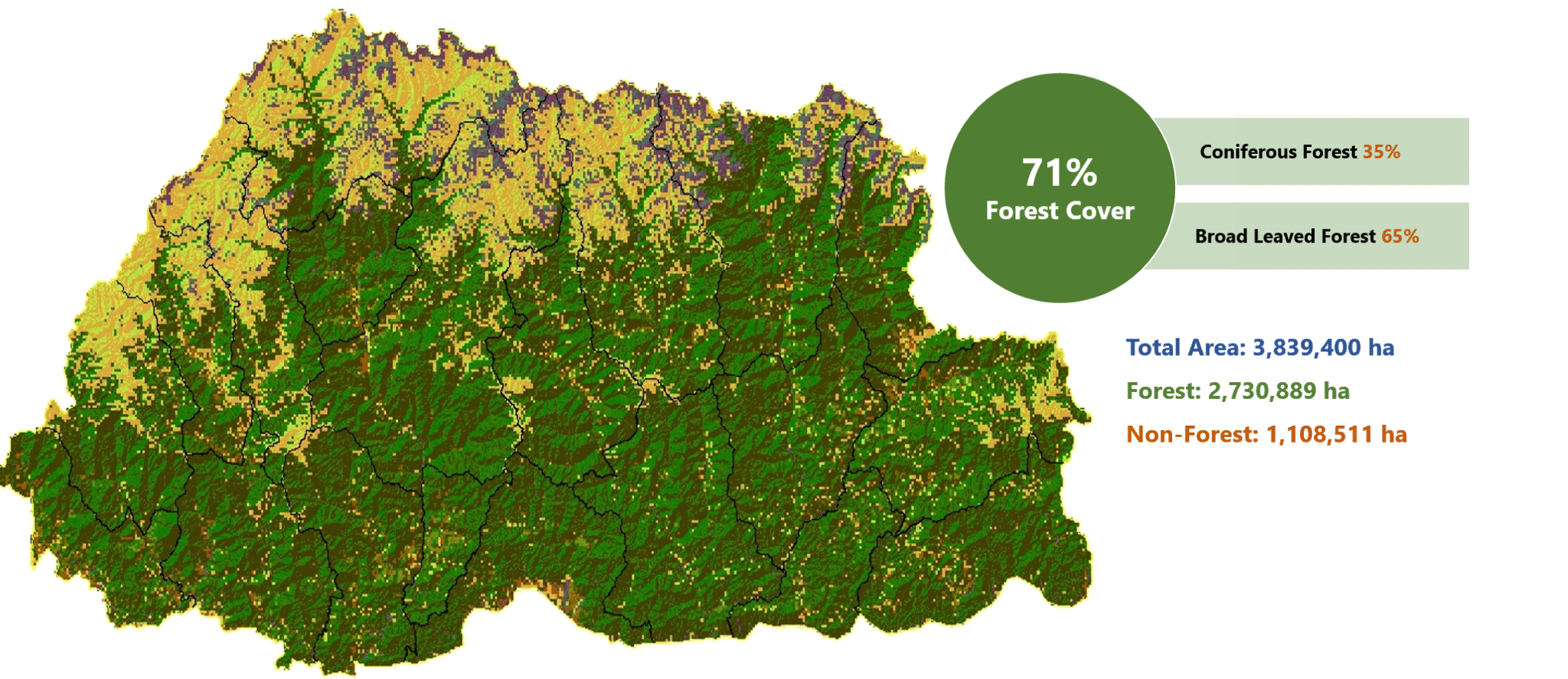
The country has diverse climatic conditions which are classified into three climatic zones — 1) the southern Subtropical foothills with high humidity and heavy rainfall; 2) the central temperate valleys characterized by cool winters and hot summers with moderate rainfall; and 3) the high Alpine mountains with cold winters and cool summers.
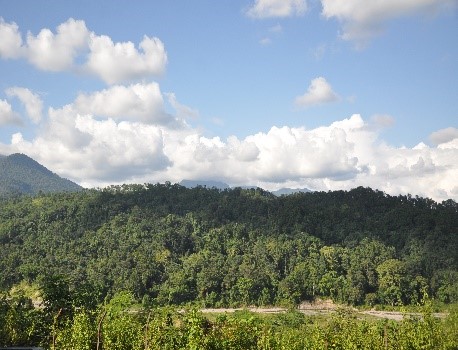
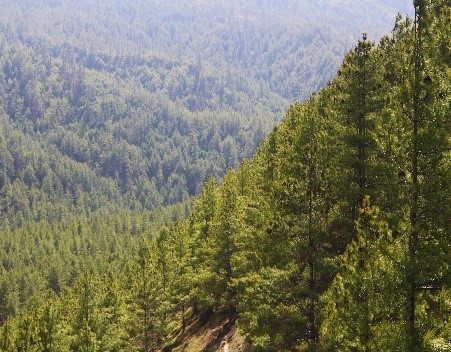
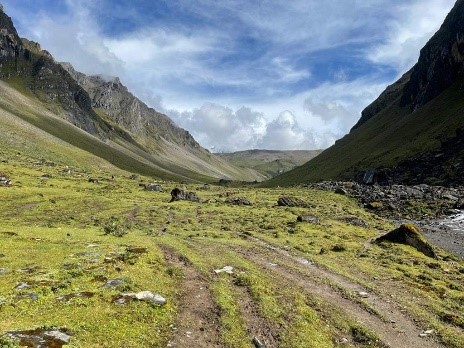
Within these zones, there are eleven forest types namely subtropical forests, warm broadleaved forests, Chir Pine forests, cool broadleaved forests, evergreen Oak forests, Blue Pine forests, spruce forests, hemlock forests, fir forests, Juniper-Rhododendron scrubs, and dry alpine scrubs. Cool broadleaved forests (26%) and warm broadleaved forests (18%) are the most common types of forest in Bhutan. Each forest type has different characteristics and species compositions.
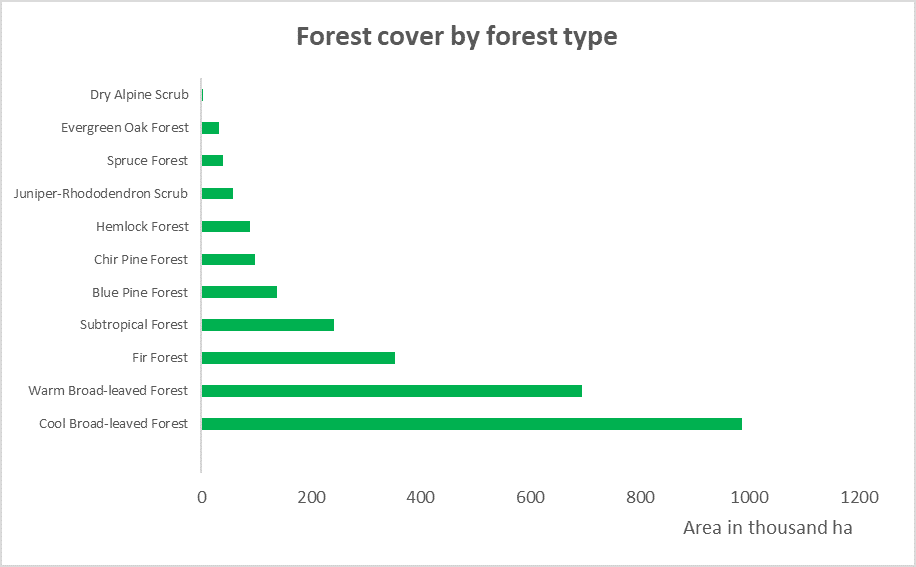
2. Forest Management Regimes
The National Forest Policy of Bhutan (2011) requires all forests to have forest management plans focused on the sustainable supply of forest products or ecosystem services. The management plans must also ensure that pests and diseases, forest fires and natural disaster management related to the particular resources form an integral part of the plan. Currently, the forest management regimes in Bhutan include:
- Protected Areas cover 51% of the country’s total area and are comprised of five national parks, four wildlife sanctuaries, one strict nature reserve which are well connected by nine biological corridors. These areas are set aside for the conservation of biodiversity and integrated development for people residing within and around these areas.
- Community Forests are areas managed by the local communities to meet their requirements for forest produce. As of December 2019, there are a total of 804 operational community forests covering an area of 40 thousand ha throughout the country (FFF,2019).
- Forest Management Unit are areas prescribed for the sustainable harvesting of timber for rural use and commercial purposes. There are 21 functional forest management units in the country.
- Local Forest Management Areas are areas outside protected areas, community forests and forest management units, and are managed under local forest management plans.
As part of sustainable forest management, the DoFPS is implementing its 2nd National Forest Inventory to assess the status of forest health and condition in the country The data collected will provide a wide range of information on biodiversity, forest resources, forest carbon stocks, and changes in the state of forest since the last inventory study (conducted between 2012 and 2015). The information generated from this exercise will form the basis of forest management policies and programs in Bhutan.



3. Policies and Legal Frameworks
The conservation and protection of the natural environment are enshrined in the constitution of the Kingdom of Bhutan (2008) wherein it mandates the Government to ensure that “in order to conserve the country’s natural resources and to prevent degradation of the ecosystem, a minimum of 60% of Bhutan’s total land shall be maintained under forest cover for all time”. Article 5.1 of the Constitution further stipulates that “Every Bhutanese is a trustee of the Kingdom’s natural resources and environment”. Bhutan’s commitment to environmental conservation has been translated into numerous Policies and Legislations. The Bhutan Forest Act (1969) and National Forest Policy (1974) were the first rules passed by the government to conserve forests. As of 2021, key acts, policies, and strategies related to forests in Bhutan are listed below.
| No. | Years | Forestry acts, policies, and rules |
|---|---|---|
| 1 | 2017 | Forest and Nature Conservation Act of Bhutan |
| 2 | 2011 | National Forest Policy of Bhutan |
| 3 | 1995 | Forest and Nature Conservation Act of Bhutan |
| No. | Years | Forest-related national acts and policies |
|---|---|---|
| 4 | 2020 | The Climate Change Policy of the Kingdom of Bhutan |
| 5 | 2018 | The Land Lease Rules and Regulations |
| 6 | 2016 | Economic Development Policy of the Kingdom of Bhutan |
| 7 | 2011 | The Water Act of Bhutan |
| 8 | 2009 | Waste Prevention and Management Act of Bhutan |
| 9 | 2007 | The Land Act of Bhutan |
| 10 | 2007 | The National Environment Protection Act |
| 11 | 2003 | The Biodiversity Act of Bhutan |
| No. | Years | Forest-related programs and strategies |
|---|---|---|
| 12 | 2020 | A Roadmap and Strategy for Strengthening Climate Change Research in Bhutan, 2021-2025 |
| 13 | 2020 | National REDD+ Strategy & Action Plan 2020-2030 |
| 14 | 2020 | National Environment Strategy 2020-2030 |
| 15 | 2018 | The 12th Five Year Plan 2018-2023 |
| 16 | 2014 | National Biodiversity Strategy and Action Plan |
4. Existing Challenges
Conservation of the environment and biodiversity as well as the sustainable management of natural resources has been one of the key focus areas in Bhutan. However, with the continued rapid pace of socio-economic development added with climate change impacts, adhering to the environmental obligations enshrined in the constitution of securing ecological balances and ensuring sustainable development is being confronted with more challenges.
The threats to natural resources include increasing pressures on biodiversity and natural resources, forest loss, and land-use conversion for various purposes is a concern that could lead to biodiversity and habitat loss. Such pressures may lead to the extinction of globally threatened species and other biodiversity resources thus creating imbalances in the ecology. The National Biodiversity Strategic Action Plan for Bhutan, 2014. identifies the following drivers as the overall threat to natural resources and biodiversity conservation in Bhutan — land-use conversion, overexploitation of timber and fuelwood, forest crimes and wildlife poaching, unsustainable agricultural practices, pollution, invasive species, human-wildlife conflict, climate change, population, overgrazing, waste, and poverty. For a small country like Bhutan with limited financial, human, and technological capacities, addressing these threats is a challenge in itself.
5. Problem Analysis vis-à-vis AFoCO’s Priority Areas
1. Forest degradation and excessive extraction of timber
The key drivers of deforestation and forest degradation in Bhutan are the allotment of State Reserve Forest Land and conversion of forests into a wide range of purposes such as hydropower projects, agriculture, mining and quarries, and installation of electricity transmission lines (REDD+ Strategy 2020). Forest degradation is also said to have negatively affected other land uses, affect the downstream water quality, and cause the emission of greenhouse gases. Therefore, the following activities are proposed:
- Promote innovative technology and approaches of restoration, rehabilitation, and reclamation of degraded forest ecosystem
- Invest on multi-purpose land management programs
- Support community plantation in degraded areas by through free supply of native species.
- Support and promote existing policies and act to address increasing forest loss
- Promote efficient utilization of the wood and wood products
- Establish plantations to provide sustainable wood-based products supply, increase carbon-stock, and enhance biodiversity
2. Climate change
A geologically fragile underdeveloped country with young mountain ecosystems, Bhutan is highly vulnerable to climate change and its impacts. Bhutan is already facing the impacts of climate change such as extreme weather, changing rainfall patterns, water shortages, emergences of diseases and pests, loss of important native and endemic species. Some of the proposed recommendations are to:
- Adopt landscape approach/biological corridors in the face of climate change to support ecological resilience.
- Increase public awareness and understanding on climate change among different groups of people at all levels through education and outreach programs including through use of print, broadcast and online media.
- Develop guidance and tools for assessing, planning, integrating and implementing adaptation and mitigation measures.
- Introduce species conservation activities like domestication of endangered, endemic and threatened lant species in disturbed terrestrial ecosystem
- Facilitate understanding of the scientific evidence and interdependencies among climate variability and change, human livelihood, disasters, and disease vulnerability at both local and national level.
3. Forest crimes and wildlife poaching
The most common forest crime reported pertains to illegal trade and transport of timber (FFF, 2019). Other offenses include wildlife poaching, illegal harvesting of NWFP, fishing, retaliatory killings of wildlife, and encroachment of State Reserve Forest Land. Some proposed activities are to:
- Strengthen monitoring and patrolling capacities of the field officers through training and workshop
- Support studies and documentation of endemic and threatened species o flora and fauna.
- Introduce advance technologies like use of Drone and Artificial intelligence to monitor forest and check illegal activities
- Provide training on legal procedure and law enforcement to local communities
- Support establishment of anti-poaching community programs in areas with high predator species.
4. Human-wildlife conflict (HWC)
Human-wildlife conflict is a growing concern in a country that has more than half of its total area designated as protected areas and at least two-thirds of the populace dependent on agriculture and livestock farming. Livestock depredation, crop damage, and retaliatory killing are some of the conflicts encountered. The key conflict species are tigers, leopards, monkeys, deers, and wild boars (FFF, 2019). Records show that about 55% of the crop damage in the country is attributed to wildlife damages (NBSAP, 2014). Since human-wildlife conflict causes substantial economic and social costs to the rural communities, it also results in retaliatory killings, resentment against policies, and a lack of support for conservation initiatives. Recommended activities are to:
- Set more awareness programs in the HWC hot spot areas
- Assist in establishing bio-fencing and solar eclectic fencing
- Facilitate wildlife research and studies such to so that decision makers can make ground reality-based decisions
- Invest in wildlife habitat improvement program in protected areas and non-protected areas.
5. Forest fires
Forest fires are key threats to the forests in Bhutan, especially coniferous forests. Annually, large forest areas are lost to fires and in 2019 itself, 3,524.72 ha of forest area was burnt (FFF, 2019). While most fires in Bhutan are caused by human activities such as the burning of agriculture debris, development of pastures, reckless behaviors of picnickers and smokers, the source of fire is not ascertained in 80% of the incidences (FFF, 2019). Recommended activities include:
- Invest more in adaptation and mitigation programs and promote community base forest fire fighting groups
- Adopt fire management approaches that limit impacts on the environment and communities
- Provide advocacy and awareness programs specially to minimize intentional fires for better agriculture production
- Conduct forest fire training for forest officials, volunteers, local communities
- Encourage more research study and real time data collection on disaster and their impacts
- Provide fire-fighting protective gears to the forest officials and volunteers
6. High dependency of local communities on natural resources
Almost all rural residents of Bhutan, which constitute 62.2% of the entire population (NSB, 2017), directly or indirectly depend on forests for their livelihoods. The high dependency of rural communities on forests and forest resources often exerts pressure on existing limited natural resources. In order to sustainably manage resources along while meeting the needs of local communities, the following activities are recommended:
- Promote participatory forestry programs in the rural areas such as Community Forestry to provide employment for the rural people while sustainably managing the forest.
- Facilitate development of project profiles/business plans for selling the business ideas
- Support income diversifying programs such as enterprise development, strategic market linkages, product development etc.
- Strengthen approaches to upscale Payment for Ecosystem Services (PES) and Nature based ecotourism
- Provide technical and financial assistance to support communities in exploring more innovative livelihood enhancement programs
- Invest in field-based and specialized training to Community Forest and Non-Wood Forest Management groups to build capacities and competence in forest management.
7. Lack of research and capacity development
At present, the DoFPS has just a handful of officials specializing in different fields of forestry (FFF, 2019). Considering the limited human resources and lack adequate financial and technological capacities in forest departments, there is a need to:
- Initiate programs to train forestry official of different level to enable efficient management and conservation works.
- Strengthen the regional cooperation through workshops and exchange visits to share and learn about the best practices and success stories of the countries in the field of climate change adaptation and mitigation programs.
- Support capacity development of all relevant stakeholders and institutions including the local governments, community groups and beneficiaries to address climate change, including through relevant national training institutions.
- Provide specialization courses to generate expertise in specific fields in conservation
- Initiate youth involvement programs through training and attachment program
- Create, promote, and strengthen national, regional, and international working groups including non-governmental organizations, and civil society to develop appropriate adaptation options.
References:
- Royal Government of Bhutan (RGoB), 2008, The Constitution of the Kingdom of Bhutan, 9.
- National Environment Commission, RGOB, 2020, The Climate Change Policy of the Kingdom of Bhutan.
- Forest Resource Management Division, Department of Forest and Park Services, RGoB, 2015, National Forest Inventory, Stocking Nation’s Forest Resources, Volume I.
- Watershed Management Division, Department of Forest and Park Services, RGoB, 2020 National REDD+ Strategy and Action Plan for Bhutan, 24-35.
- Gross National Happiness Commission 2018, 12th Five Year Plan Bhutan 2018-2023.
- National Center for Hydrology and Meteorology 2021, Bhutan Glacial Lake Inventory, Thimphu, Bhutan.
- Department of Forest and Park Services 2019, Forestry Facts and Figures, 10-54.
- National Statistical Bureau 2017, Population & Housing Census of Bhutan, 10-15.
Contributed by Sapanar Sunar, 2021 AFoCO Fellowship Official from Bhutan

